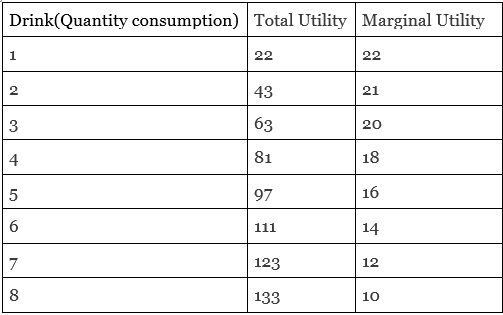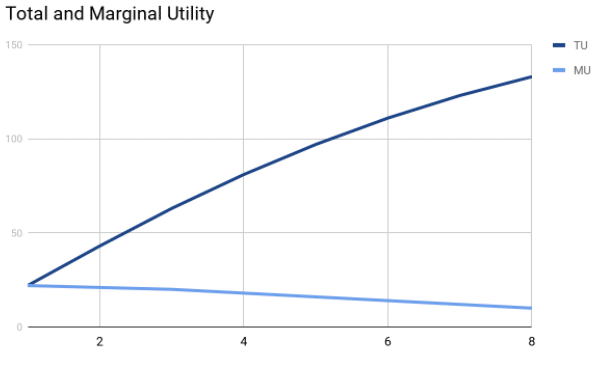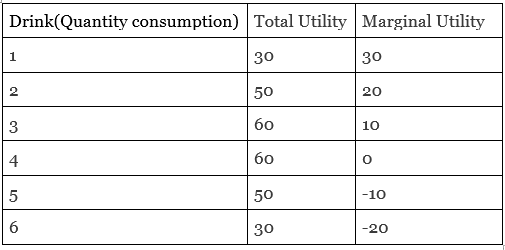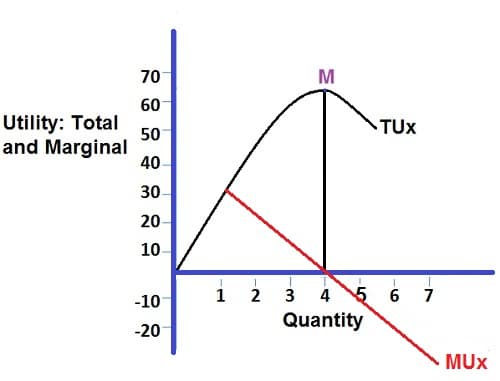Definition: Cardinal Utility approach was given by neo-classical economists, who said that satisfaction gained after using a certain commodity can be termed as Utility. Also, they assumed that cardinal utility can be measured in quantitative terms (or money), like 1,2,3,4 and so on.
Meaning of Cardinal Utility:
Consumers can express their satisfaction after consuming goods and services known as a cardinal utility. Since cardinal utility theory holds measurability and quantifiable entity therefore it can be used for intrapersonal and interpersonal comparison.
Although for measuring the satisfaction level of the consumers, the cardinal utility is measured in “utils” but it has no unit.
For example: If Ram purchases two shirts like X and Y giving him 300 and 400 utils of satisfaction respectively so it can be inferred that shirt Y provides him with a greater level of satisfaction.
Measures of Cardinal Utility
There are certain assumptions that need to be kept in mind in cardinal utility analysis apart from the quantifiable nature of cardinal utility, which is as follows :
- A single unit of a certain commodity will provide the same level (utils) of satisfaction to all individuals. eg: If the first chocolate provides 50 utils of satisfaction to Ram then the same commodity will provide the same satisfaction to Shyam as well.
- Transitivity: IF a good X is preferred over Y (X>Y) by a customer and good Y is preferred over Z (Y>Z) then he must prefer X over Z(X>Z).
- Completeness of commodity: There can be 3 situations –
Whether RED is preferred over BLUE OR BLUE is preferred over RED OR RED and BLUE are equally attractive.
- Marginal utility of money: Daniel Bernoulli introduced that measurement of goods can be done in terms of money only if the marginal utility of the money remains constant, in order to get the cardinal utility analysis in one common term.
Cardinal utility theory :
Cardinal utility theory explains that there are two basic concepts that explain it all together which are as follows –
- Total utility (TU)
- Marginal utility (MU)
Total Utility:
Total utility refers to the total satisfaction derived by the consumer after consuming a certain(fixed) quantity.
The higher the consumption, the higher the level of satisfaction of the consumer. TU is commonly used as a short-term for total utility. However, the term TUn represents the total satisfaction gained from a number of quantities.
Marginal Utility:
Marginal Utility (MU) refers to the extra satisfaction obtained from consuming one more unit of the commodity.
Therefore it can be denoted as the change in total utility because of one additional unit of a commodity.
For example, suppose 10 ice cream gives us 50 utils of total utility, and on 11thice cream, TU reaches 60. Hence, the 11th ice cream consumption has caused the total utility to increase by 10 utils (60 utils- 50 utils). Therefore, MU received from the 11th ice cream is 10 utils.
MU11 = TU11 – TU10 = 60 – 50 =10
The equation to find the MU of the nth unit is ‘MUn = TUn – TUn-1’, where n refers to the nth unit of the commodity.
The relation between total utility and marginal utility is equated in the following way:
TUn = MU1 + MU2 + … + MUn-1 + MUn
TUn = ∑MU
Therefore, TU derived from the consumption of n units of ice cream is a total of MU of the first ice cream, MU of the second ice cream till the nth unit.
Marginal Utility Example with Graph
To understand the concept of cardinal utility more clearly, here is an example of how the total utility and marginal utility can is calculated and their representation on the graph:


Law Of Diminishing Marginal Utility
It is studied that the consumer always wants to increase his consumption to attain greater levels of satisfaction from the cardinal utility above. But as the consumption increases, extra satisfaction or marginal utility derived from each additional unit starts to decline, which is known as the Law of Diminishing Marginal Utility of the commodity(further used for Marginal Rate of Substitution).
For eg: Ram is hungry and grabs an apple. The amount of satisfaction attained by him is 50 utils. Now if he wishes to have another one, he might not get the same feeling in the second one which explains that the first commodity provides the greatest satisfaction to the consumers and he might be reluctant to have further.
Also, since marginal utility decreases with more consumption therefore its curve is downward sloping.
Relationship Between Total Utility and Marginal utility
According to the example:
- When TU increases, the MU decreases but remains positive (which states that the consumer can have more)
- When TU is maximum, the MU becomes zero ( this is the point where the customer stops )
- Afterwards, TU starts declining and MU becomes negative (here an extra unit gives dissatisfaction to the consumer)
Law Of Diminishing Marginal Utility- Graphical Representation


Causes of Diminishing Marginal Utility:
Causes of occurring diminishing marginal utility, why the cardinal utility can be expressed in negative as well:
Satisfaction of a Particular Commodity
Human wants and desires are unlimited but the particular desires for specific commodities are limited. Therefore, it is possible to satisfy the limited wants of humans. With the increasing number of items, a person’s desire to consume more commodities becomes less. So, with the consumption of each successive unit marginal utility becomes smaller. Hence, consuming too many units of a commodity brings complete satisfaction to humans.
Introspection
The Law of diminishing marginal utility is created by examining people’s thoughts and their mental reactions. Classical economists used to look into their minds for their psychological response to the extra consumption of a particular thing (say, an apple, an ice cream, chocolate, etc.) and tested the reality behind the law.
Less Important Uses of Additional Quantities
Also, diminishes MU can cause because of the consumption of several units capable of alternative uses. Consumption of the most crucial use can take one unit, and additional units can be used to take from alternative products to less essential uses.
Drawbacks of Law of diminishing marginal utility
The Law of diminishing marginal utility has some drawbacks. This law might not be applicable in certain circumstances. In the case of exceptional cases, MU might increase for some time, whereas cardinal utility might work. Six important exceptional cases to the law are:
Change of Taste and Preferences
In case of a change in consumer tastes and preferences, he can like a commodity more, so the MU of any commodity price rises.
For example, a person initially might not have any interest in eating pizza. But after eating one pizza, he may get a better taste for pizza and may get better satisfaction from the 2nd or the 3rd one.
Inadequate Initial Consumption
If the initial quantity of a commodity is minimal, a person might not get satisfaction. In this case, a person will have a high level of satisfaction in 2nd or 3rd consumption.
For example, a glass of water might not fully fill the person's thirst, but the 2nd or 3rd glass will do.
Emotional or Fancy Buying
The Law of marginal utility is not applicable when a consumer is buying something fancy or things to which they are emotionally attached.
An example is the artwork of a known painter or a rare book of a dead author.
Miser’s Collections or Hobby Collections
A miser (a person who likes collecting money) will get more and more satisfaction from the additional money. Similarly, a person who likes collecting things, e.g., stamps, coins, works of art, etc…will also get more and more satisfaction with additional units as hobby-collections satisfaction increases gradually.
Consumption at Different Time Periods
If the consumption of a particular commodity of different units and at different times, MU from additional units is not likely to decrease.
For example, consumption of the same food in three other meals of the day, MU may not diminish.
Stock with Other Persons
In many cases, utility depends upon the stock available to others; let’s say in a locality, one person has more than one car, and the other car’s utility will not diminish.
Here was the topic of cardinal utility and all the other related, which come under cardinal utility.
Although the cardinal utility is from the point of view of the consumers, the laws of return to scale are understood with respect to the producers which is studied further.
Frequently Asked Questions (FAQs)
what is cardinal utility?
Cardinal utility is used to state the level of satisfaction which a consumer receives after consuming any goods or services, which can be measured and expressed in quantitative numbers.
What is the Difference Between ordinal utility and cardinal utility?
The difference between cardinal utility and ordinal utility is that in Ordinal utility the level of satisfaction of user goods can be ranked in order of preference but cannot be evaluated numerically. On the other hand, cardinal utility is a utility that determines the satisfaction of a commodity used by an individual and can be supported with a numeric value.
What is the cardinal utility approach?
The Cardinal Utility approach was given by neo-classical economists, who said that satisfaction gained after using a certain commodity can be termed as Utility. Also, they assumed that cardinal utility can be measured in quantitative terms (or money), like 1,2,3,4 and so on.